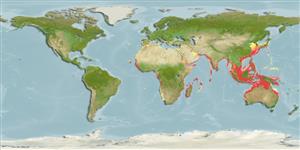分類 / Names
共通名の | 類義語 | Catalog of Fishes(部類, 種) | ITIS | CoL | WoRMS | Cloffa
板鰓亜鋼(サメとエイ類) (sharks and rays) >
Carcharhiniformes (Ground sharks) >
Carcharhinidae (Requiem sharks)
Etymology: Rhizoprionodon: rhiza (Gr.), root; prion (Gr.) saw; odon (Gr.), tooth, referring to teeth with serrated (saw-like) bases, or roots [replacement name for Rhizoprion Ogilby 1915, preoccupied by Rhizoprion Jourdan 1861 in mammals]. (See ETYFish); acutus: Latin for sharp or pointed, probably referring to narrow, pointed snout. (See ETYFish).
More on author: Rüppell.
Environment: milieu / climate zone / depth range / distribution range
生態学
海; 新鮮な水; 汽水性の 底生の漂泳性; 両側回遊性 (Ref. 51243); 深さの範囲 1 - 200 m (Ref. 244). Tropical; 41°N - 30°S, 27°W - 156°E
Eastern Atlantic: Madeira and Mauritania to Angola (Ref. 244). Indo-West Pacific: Persian Gulf (Ref. 68964), Red Sea and East Africa to Indonesia, north to Japan, south to Australia. Also reported from Gulf of Taranto in Mediterranean Sea (Ref. 231).
Length at first maturity / サイズ / 重さ / 年齢
Maturity: Lm 75.0, range 70 - 80 cm
Max length : 175 cm TL オス/雌雄の選別がない; (Ref. 12693); 80.8 cm TL (female); common length : 110 cm TL オス/雌雄の選別がない; (Ref. 47737); 最大公表体重: 5.0 kg (Ref. 40637); 最大記録サイズ: 8 年 (Ref. 244)
背面の脊椎 (合計) : 0; 肛門の骨: 0. A small shark with a long, narrow, snout, big eyes without notches, long labial furrows, and oblique-cusped teeth which may be smooth-edged or weakly serrated; 2nd dorsal fin small, low and behind larger anal fin; no interdorsal ridge (Ref. 5578). Grey or grey-brown above, white below (Ref. 5578). Dorsal and anal fins with dusky or blackish edges, fins slightly darker than back (Ref. 9997).
Found on continental shelves, often on sandy beaches and rarely in estuaries (Ref. 244). Reported to enter freshwater and recorded several times from Cambodia as far upstream as the Great Lake (Ref. 12693). Occurs near the surface in shallow waters (Ref. 12693). Feeds mainly on small pelagic and benthic bony fishes, also cephalopods and other invertebrates (Ref. 244). Viviparous (Ref. 50449). Utilized fresh and possibly dried salted for human consumption and for fishmeal (Ref. 9997). The 178 cm specimen recorded off Africa is possibly based on some other species (Ref. 9997).
Distinct pairing with embrace (Ref. 205). Viviparous, with a yolk-sac placenta; 2 to 8 in a litter (Ref. 9997), usually 2 to 5 after a gestation period of ~ 12 months; no seasonality in the reproductive cycle (Ref.58048). Size at birth between 25 and 39 cm.
Compagno, L.J.V., 1984. FAO Species Catalogue. Vol. 4. Sharks of the world. An annotated and illustrated catalogue of shark species known to date. Part 2 - Carcharhiniformes. FAO Fish. Synop. 125(4/2):251-655. Rome: FAO. (Ref. 244)
Human uses
水産業: 商業; ゲームフィッシュ: はい
用具
特記事項
XMLをダウンロードして下さい
インターネットの情報源
Estimates based on models
Preferred temperature (Ref.
123201): 19.6 - 28.5, mean 26.9 °C (based on 1463 cells).
Phylogenetic diversity index (Ref.
82804): PD
50 = 0.5078 [Uniqueness, from 0.5 = low to 2.0 = high].
Bayesian length-weight: a=0.00339 (0.00273 - 0.00421), b=3.08 (3.04 - 3.12), in cm total length, based on LWR estimates for this species (Ref.
93245).
栄養段階 (Ref.
69278): 4.3 ±0.4 se; based on diet studies.
Generation time: 5.5 ( na - na) years. Estimated as median ln(3)/K based on 1
growth studies.
回復力 (Ref.
120179): 非常に低い, 14年以上の倍増期間の最小個体群 (K=0.2-0.6; Fec=1).
Fishing Vulnerability (Ref.
59153): High vulnerability (61 of 100).
Nutrients (Ref.
124155): Calcium = 16.4 [2.3, 90.2] mg/100g; Iron = 0.575 [0.146, 1.652] mg/100g; Protein = 21.2 [18.2, 23.5] %; Omega3 = 0.198 [0.082, 0.472] g/100g; Selenium = 58 [16, 171] μg/100g; VitaminA = 20.7 [7.9, 53.8] μg/100g; Zinc = 0.698 [0.324, 1.318] mg/100g (wet weight);
